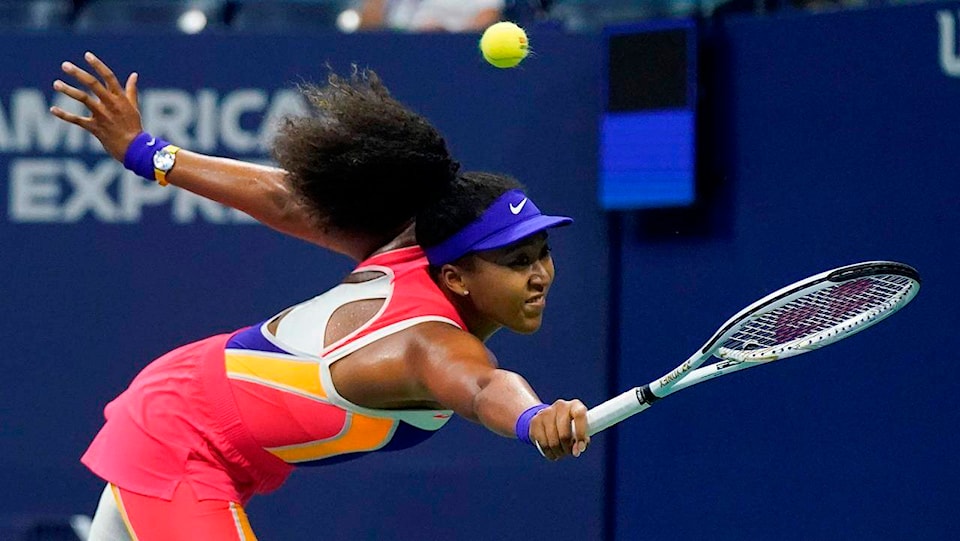NEW YORK — It wasn’t until Naomi Osaka got a little help from a fortunate net-cord and an incorrect line call that she finally was able to get the better of Jennifer Brady in a U.S. Open semifinal filled with fast serves and strong forehands.
And now Osaka, still just 22, is one victory away from a third Grand Slam title.
Osaka finally surged ahead midway through the last set with the only service break she would get Thursday night — and only she would need — to beat Brady 7-6 (1), 3-6, 6-3, returning to the final at Flushing Meadows two years after winning the championship.
The match was played with the retractable cover at Arthur Ashe Stadium shut, and rain loudly pelted the roof. That also created an indoor environment conducive to the clean hitting both women produced, the thud of racket-on-ball echoing off thousands of empty blue seats at a tournament closed to spectators because of the coronavirus pandemic.
“It means a lot for me. I kind of consider New York my second home,” said Osaka, who was born in Japan and moved to the United States as a child. “I kind of love the atmosphere, even though there’s no people here. I feel like this court kind of suits me well.”
Suited both players just fine for most of the high-quality semifinal.
Osaka served at up to 120 mph; Brady reached 117 mph. And they pounded the ball once it was in play, too, particularly off the forehand side.
“I just felt like I was sticking it out. It felt like we were trading serves,” Osaka said. “I tried to adjust a little bit on her serve in the third set so maybe that helped.”
They combined for 70 winners — 35 apiece — to just 42 unforced errors, each as good as the other, and it took a bit of luck to swing things after 1 hour, 45 minutes.
That’s when, at 2-1 in the third set, Osaka earned her first break point with a backhand that clipped the net tape and trickled over. She was able to convert the chance when she hit a deep return of a 110 mph serve, and Brady’s backhand in response was called long — although a television replay showed it actually caught a piece of the back of the baseline.
Brady did not challenge the ruling.
Ashe is one of only two courts at the U.S. Open using line judges this year; to reduce the number of people on site, the tournament used electronic line-calling in the other arenas.
In Saturday’s final, Osaka will face 23-time major champion Serena Williams or two-time major champion Victoria Azarenka.
Williams entered that semifinal, scheduled for later Thursday night, with an 18-4 head-to-head advantage over Azarenka, including 10-0 in Grand Slam tournaments, with victories in the 2012 and 2013 U.S. Open title matches. The only opponent Williams has played more often is her older sister, Venus; they’ve met 31 times.
The men’s semifinals are Friday, with Dominic Thiem vs. Daniil Medvedev, and Alexander Zverev vs. Pablo Carreño Busta. None of the final four men has won a Grand Slam trophy.
The opening set of the first women’s semifinal came down to the tiebreaker and Osaka was superior, maybe owing to her greater amount of experience in such situations.
She didn’t make a single error — Brady’s lone point arrived via an ace — and cooly closed it out with a 120 mph ace.
That was the first set ceded by Brady in the two-week tournament, but she also hadn’t faced anyone the calibre of Osaka, whose resume also includes the 2019 Australian Open trophy and status as the first Asian tennis player to be ranked No. 1.
In the second set, though, it was Osaka who blinked, and Brady who collected the first break of the evening. She went ahead 5-3 when Osaka missed a forehand on a 19-stroke exchange, then served it out.
Heady stuff for Brady, a 25-year-old from Pennsylvania who never had been past the fourth round of a Grand Slam tournament before this week.
___
Follow Howard Fendrich on Twitter at https://twitter.com/HowardFendrich
___
More AP tennis: https://apnews.com/apf-Tennis and https://twitter.com/AP_Sports
Howard Fendrich, The Associated Press
